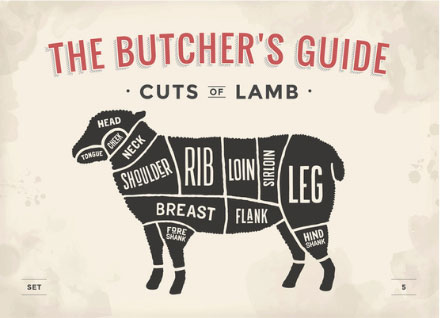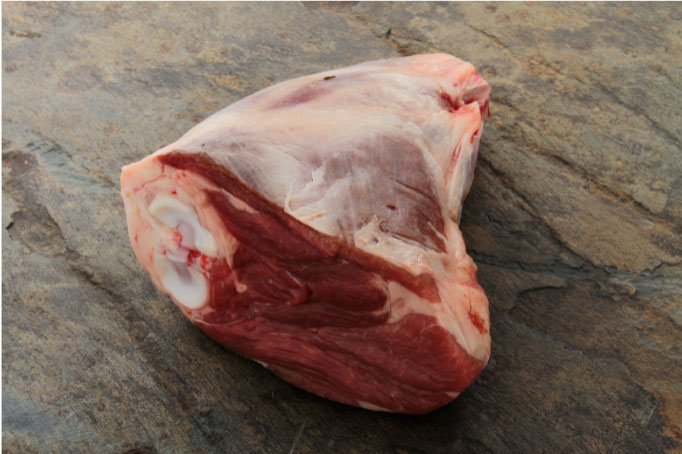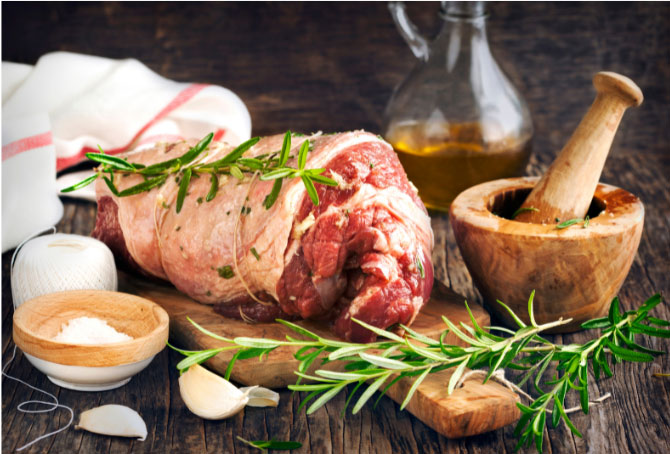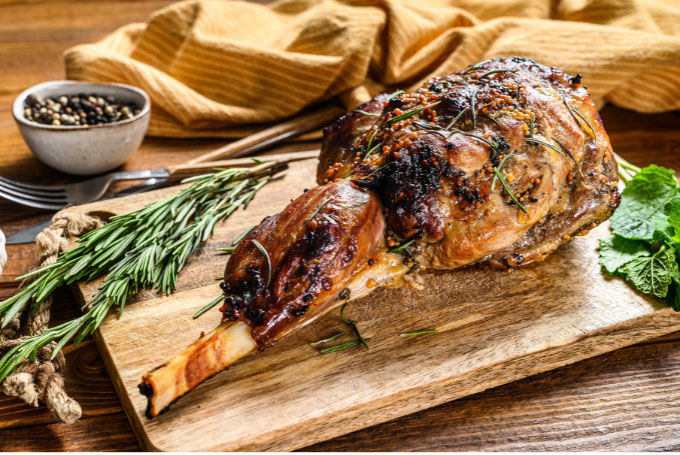New Zealand has the best lamb in the world. Our lush green pastures, fresh air and warm sunshine provides a perfect natural environment for lamb to thrive. Our lamb is lean and tender, nutrient rich and bursting with flavour.
There are so many different ways to enjoy lamb. Kiwis love the traditional roast leg of lamb as it makes an absolutely delicious Sunday roast to feed the entire family. Lamb perfectly rises to the occasion, when a celebratory roast is called for and bringing a whole roast leg to the table is guaranteed to impress your guests.
The Greek prefer slow cooked lamb, Americans love butterflied lamb on the BBQ grill, the Italians cook their lamb in wine and in Morocco they like their lamb rich and spicy.
We share some of our favourite ways to cook lamb leg below and hope you will be inspired to try a new approach at home.

What is leg of lamb?
A lamb has four legs and it's only the two hind legs which are referred to as leg of lamb. The whole leg of lamb is a large cut of meat and runs from the lower back, down the hind, to just above the foot.
The whole leg is sold with the option of bone in or boneless and can be butchered and sold as smaller cuts such as leg steaks. The bottom section below the knee is the lamb shank and is often removed and sold separately. What's left is called a short-cut lamb leg.

Bone in lamb leg
Leaving the bone in the leg whilst cooking is recommended, as it can enhance the depth of flavour.

Boneless leg of lamb
If you haven't got time for slow cooking, then buying a boneless leg of lamb might be the answer. A boneless leg is opened and deboned leaving all the meat and fat layer intact. Boneless lamb legs cook faster and can be cooked in less than two hours.

Butterflied leg of lamb
When butterflied, a lamb leg is trimmed, opened and deboned then flattened out like a spatchcock chicken. It retains all the meat of a leg roast without the bone and much less fat. This allows for seasoning and marinating on both sides. It can be grilled within less than one hour, depending on thickness.
Lamb is a high quality protein
Lamb is a delicious, healthy choice for fulfilling the high quality protein needs of your family. Lamb is a red meat which is nutrient dense and contains 12 essential nutrients including iron, zinc and B vitamins.
What to look for when buying a whole leg of lamb
Lamb should be a muted red or reddish brown colour. The leg should still have the fat cap on, which can be partially removed or better still, left to render down during roasting where it bastes the rest of the meat keeping it moist and full of flavour.
To feed 6-8 people buy a leg with bone-in weighing 2.25kg.
Storing and freezing lamb leg
Refrigerating lamb
The lamb leg should be left in its original packaging, then placed in a sealed, leak proof plastic bag to prevent dripping or leakage onto other food. Place in the refrigerator on the lowest shelf for up to four or 5 days after purchase and eat within the 'Use by Date'.
Leftover roast lamb will keep in the fridge for 3 days. Ensure the lamb has cooled before transferring to a tight-lidded glass container to refrigerate.
Marinating lamb
If your recipe calls for marinating overnight, place the lamb back in the refrigerator after applying the marinade.
Freezing lamb
Fresh leg of lamb can be frozen in its original packaging for up to 6 months in a freezer.
You can also freeze cooked lamb. First carve the meat, remove the bone, and store the lamb in freezer-safe containers or zip-top bags for up to 2 months. Thaw overnight in the fridge. Reheat the thawed meat in the oven, covered, with a bit of liquid in the baking pan until warmed through.
Defrosting lamb
Lamb must be defrosted completely before cooking. The safest place to defrost lamb is in the refrigerator and it will take up to 24 hours to defrost completely. It's important to leave the lamb in its sealed packaging and sit it on a dish to catch any leaks or drips. Cook lamb as soon as it is defrosted or it could spoil.
How to make the perfect roast leg of lamb?

Kiwis love roasted lamb and we're going to show you how to make the perfect roast leg of lamb with delicious gravy. We'll also share the best side dishes to make your roast lamb dinner complete:
Remove lamb from the refrigerator 1 hour before roasting to bring it nearer to room temperature.
- Trim and remove any silvery connective tissue but leave the fat cap in place. If there is an excessive layer of fat on top, you can slice some of the top layer off.
- Preheat the oven to 220 degrees Celsius with a deep shelf in the centre.
- Prepare a wet rub: Mix 3 minced garlic cloves, 1 Tbsp Dijon mustard, 1 Tbsp olive oil, 1 Tbsp chopped fresh rosemary, 1 Tbsp of lemon zest and seasoning together and put aside until the meat is at room temperature.
- Cut 2 whole garlic cloves in half and place these cut side up in the roasting pan with a few sprigs of fresh rosemary.
- Pat lamb dry, with a paper towel, then use a sharp knife to make shallow cuts all over. Use a pastry brush to spread the rub mixture over the surface and place lamb on the cut garlic and rosemary sprigs in the roasting pan.
- Roast lamb for 20 minutes, fat side up, then reduce the temperature to 180 degrees Celsius fan forced. Roast for a further 2 hours before checking the internal temperature with a meat thermometer (see temperature chart below).
- Once the meat is cooked to your liking, remove and transfer to a warm plate, cover with a foil tent and rest lamb for 30 minutes. Once rested, take a sharp carving knife and carve the lamb off the bone, in the direction of the grain and serve with lamb gravy and the sides we recommend below.
How long does it take to roast a leg of lamb?
If your leg of lamb is a different size, adjust the cooking time. For medium done, follow these cooking times.
- 1.5kg - 1 hour 40 minutes
- 2kg - 2 hours 5 minutes
- 2.25kg - 2 hours 30 minutes
- 2.5kg - 2 hours 50 minutes
- 2.75kg - 3 hours
Internal Temperature guide for Bone-in Leg of Lamb
Always use a meat thermometer to check the internal temperature of your lamb. It removes the guesswork and will help you get perfectly pink lamb every time.
- Rare lamb - 50 degrees Celsius
- Medium rare lamb - 55 degrees Celsius
- Medium lamb - 60 degrees Celsius
- Well done lamb - 70 degrees Celsius
- Fall apart tender lamb - 80 degrees Celsius
Sides to serve with roast leg of lamb
The two most important sides to serve with roast lamb are gravy and mint sauce.
Potato, carrot parsnip and peas are the perfect vegetable accompaniments for cooked lamb. You can roast potatoes, mash potatoes, boil new potatoes and for a special occasion serve Hasselback potatoes. Carrots and parsnips are also delicious roasted in the oven then drizzled in a little local honey to add extra sweetness to counter the gamey flavour of the lamb.
How to make lamb gravy
Don't waste all those delicious juices left in the roasting pan, they'll make a wonderfully flavorful gravy to accompany your roast. Empty the fat and juices into a small pan and heat on the hob until bubbling. Add flour ( 4 Tbsp.) and cook for 1 minute. Add 600ml of beef stock or beef broth slowly, stirring constantly. Season to taste and simmer until it starts to thicken. Strain and pour into a warm gravy boat ready to serve.
Leftovers
Any leftover lamb can go into sandwiches the next day or chopped and added to feta and salad in a wrap or pita bread.
LAMB RECIPES
Greek Lamb Kleftiko
Lamb Kleftiko is a traditional Greek lamb recipe, where the bone in leg is marinated in garlic, olive oil and lemon juice then wrapped loosely in a tent of aluminium foil and slow roasted in the oven or on top of a hooded barbecue. It creates tender fall apart lamb which is wonderful served with small roast potatoes, Mediterranean roast vegetables, hummus and tzatsiki.Moroccan Lamb
The robust flavour of lamb allows it to be seasoned with strong spice mixes and aromatics without the lamb being overpowered. Create a Moroccan inspired lamb leg with a rub made with Harrisa or Ras el Hanout, then roast slowly. Serve with hummus, plain yoghurt and warmed pita bread.Butterflied Lamb with Chimichurri
This is an impressive dish which can be prepared in less than an hour. Buy a boneless or butterflied leg of lamb for this delicious recipe. Marinade the whole leg in a mix of olive oil, lemon juice, thyme, garlic, sea salt and pepper. Preheat the grill and grease the grate well. Grill the lamb for 30-35 minutes, turning occasionally until the internal temperature reaches your preferred level (see temperature chart above). Let lamb rest, then slice and serve with Chimichurri sauce - a wonderfully garlicky, vinegar based herb sauce.New Zealand lamb is at its best in Spring
Lamb legs are available all year round but nothing quite beats New Zealand Spring Lamb. September to November is the best season to enjoy locally reared lamb and now that you have some new recipe ideas we hope you'll feel inspired to try a new way of cooking them.
